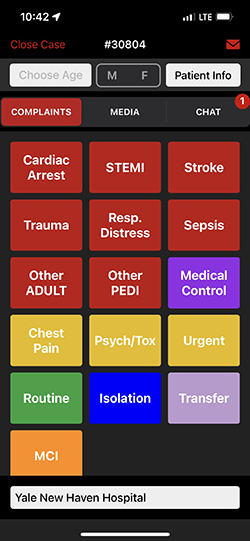
Popular Locations
- Yale New Haven Children's Hospital
- Yale New Haven Hospital - York Street Campus
- Yale New Haven Hospital - Saint Raphael Campus


All Yale New Haven Health delivery networks will soon be using an application designed to help first responders in the field send detailed patient information to our hospitals and better prepare emergency departments.
The Twiage EMS notification application launched at Bridgeport Hospital’s Emergency Department last September and Yale New Haven Hospital’s four ED locations in January. It is expected to be implemented at Lawrence + Memorial and Westerly hospitals’ EDs in late spring, followed by Greenwich Hospital’s ED.
With Twiage, emergency medical services (EMS) first responders can use cell phones to securely send information about patients’ conditions, including photos, videos and audio recordings. The information is encrypted for security and HIPAA compliance. Once sent to the hospital, it is purged from the user’s device and can’t be recovered or viewed.
Twiage also employs GPS tracking to provide ED staff real-time updates on patients’ arrival times.
“The early notification, patient details and tracking information make the ED intake process more efficient,” said Scott Martus, education and operations manager, YNHH Center for EMS.
Twiage information is also sent to YNHHS’ Capacity Coordination Center and can be shared with service lines such as Trauma Services, Heart and Vascular and Neurology for patients who will require specialized services immediately upon hospital arrival.
Twiage will augment YNHHS’ use of Connecticut’s Central Medical Emergency Direction (CMED) service. CMED staff use radio channels to provide a link between ambulances in the field and hospitals.
Because the service’s communication centers are divided into regions throughout the state, there are disparities in the technology and staffing available by region, Martus said.
On the first day of Twiage implementation at YNHH, EMS personnel used the app for 200 of the more than 300 patients brought to the ED.
“This was a successful rollout, and we look forward to bringing the remaining DNs onto this platform,” Martus said. “Creating a single ED - EMS alert system for the health system will enhance the quality, efficiency and consistency of care our hospitals and EMS professionals provide.”